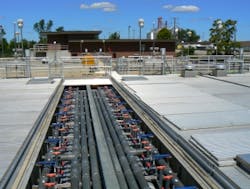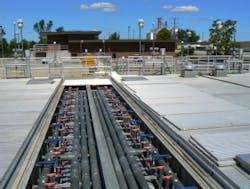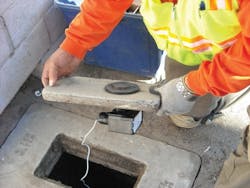By Ben Grumbles
Americans want national policies to achieve and maintain energy independence and homeland security but what about water? What do citizens, governments, and organizations want if and when they think about water? As a country, we’re all over the map, and that’s not always a good thing, particularly when short-sighted or uncoordinated actions and programs work at cross purposes or create barriers to water sustainability.
The Clean Water America Alliance believes now is the time to press for more innovative, integrated, and sustainable water policies and to do so through local, regional, and national collaborations. Now is not the time, however, to call for cookie-cutter federal mandates or guidelines that ignore the scientific or political realities. More than ever, the U.S. needs locally driven, watershed based principles to help public and private sector leaders usher in policy improvements and environmental results.
The alliance launched three national dialogues from 2009-10 to get the ball rolling and the collaboration for common ground moving. The meetings brought together experts and leaders in the drinking water, wastewater, stormwater, water reuse, and water management fields with their counterparts in the agricultural, industrial, environmental, energy, and finance areas.
The first national dialogue – The Need for an Integrated National Water Policy – resulted in a call for a flexible framework policy based on water resource sustainability. It examined the details of how such a policy would address pressing issues as the energy/water nexus, water quality and water quantity, green infrastructure, and watershed management. The second dialogue – What’s Water Worth?– examined the economic, environmental and social consequences of significantly undervaluing this precious natural resource. The third dialogue – Managing One Water – focused on breaking down “silos” within the water community to better integrate drinking water, wastewater, groundwater, reuse, and stormwater management; to improve stakeholder relations; and to advance regional water sustainability.
All three dialogues embraced the need for an integrated national water policy framework. While each had a unique focus, many common elements were identified including the urgency of the problem, the need to shift the water paradigm from a culture of conflict to one of collaboration, and the importance of bringing more voices and viewpoints into the discussion. All three reports are available at www.cwaa.us.
The three dialogues have laid a foundation for advancing shared principles of water sustainability for a national policy framework. The alliance believes these principles should be neither top-down nor bottom-up. They must combine the best of national (though not necessarily federal) policy, guidance, and funding with local/regional implementation, experimentation, and accountability (including cost sharing), such as through a multi-stakeholder watershed management approach.
In addition to the alliance’s national dialogue series, a diverse group of entities at all levels also are reflecting on the need for a more integrated approach to water management including, for example, the White House Council on Environmental Quality’s efforts to update the “Principles and Guidelines” for water and land related resources, the Johnson Foundation’s “Charting New Waters: A Call to Action to Address U.S. Freshwater Challenges”, the American Water Resources Association’s National Water Resources Policy Dialogue, and the Horinko Group’s Water Salon Series.
Following its dialogues, the alliance drafted a set of Principles to articulate a possible direction forward. The alliance convened a meeting of over a dozen large water-related trade associations in January 2011 in Washington, DC, to review and receive feedback on the draft. The resulting Principles are set forth below. The alliance will continue to solicit input on these Principles from other major water stakeholders in the months ahead.
Essential Principles for Water Sustainability: Moving Toward a National Policy Framework
I. Valuing Water
Clean, safe water is undervalued and the current water pricing system does not reflect its true cost or value. There is a tremendous need for a better understanding of and appreciation for the worth of clean and safe water. True water valuation will capture the treatment and transmission costs of water, water’s essential role in human and ecosystem health and survival, its economic contributions to recreation and tourism, and the cultural, spiritual, and aesthetic elements of water. Properly valuing water goes beyond pricing and financing. It includes recognition that this finite resource needs an ethic to ensure water and watersheds are used and protected more effectively, efficiently, and equitably.
Steps should be taken to improve how the public and policy makers value clean and sustainable water and shape public policy affecting it. Ideas suggested during the national dialogue series include dramatically increasing outreach and educational efforts on the value of water, moving toward a true cost pricing system and life cycle planning, better integrating water-dependent sectors, investing in sustainable solutions, and improving cooperation across political and watershed boundaries.
II. Sustaining Water
Sustainability of water resources and aquatic ecosystems is another critical building block and one that will become all the more critical given a changing climate. The first dialogue focused on four major elements of sustainability: energy/water nexus, integrating water quality and water quantity, green infrastructure, and watersheds. Ecosystem restoration and protection, climate adaptation, and water efficiency are additional factors that should be considered under this category.
Energy/Water Nexus
Clean and reliable water will continue to have a profound impact on the development of domestic energy sources and greenhouse gas emissions in the 21st Century – and vice versa. Two of the country’s most important physical resources, energy and water, must be used wisely and efficiently, particularly in the context of climate change and clean air policy. We will need to connect the dots, drops, and watts to support technological, fiscal and institutional innovation. Resource recovery, including the capture and reuse of nutrients, is particularly promising.
Water Quality and Water Quantity
One of the toughest water challenges is coordinating water quality laws, regulations and organizations with their water quantity counterparts. Water quality traditionally has been guided by Federal and state laws, while water quantity has been the domain of the states. Bridging long-established interests to integrate management of water quality and water quantity to ensure clean and reliable water for people and the environment will require significant discussion and negotiation among stakeholders. Better data sharing and collaboration are needed as well as investments in tools that integrate water quality and quantity.
Water Efficiency
Water efficiency, as well as conservation, should play a key role in water policy. This is particularly true given the high per capita use of water in the U.S. when compared to other nations. Water efficiency helps communities stretch existing water supplies, lessen the demand on infrastructure, save money, reduce pollution, and protect wildlife and ecosystems. When combined with wise policies on conservation and reuse, efficiency reduces water “waste” (such as leakage and disposal) without sacrificing performance or customer satisfaction.
Green Infrastructure
Today, many areas of the country recognize they must do a better job of managing their stormwater, wastewater and water supplies to ensure safe, healthy, and sustainable communities and a clean environment. Many states and municipalities are exploring and adopting more holistic approaches to watershed management and stormwater control, including non-traditional, “green infrastructure” approaches such as vegetated swales, rain gardens, porous concrete, and rain barrels. While by no means a silver bullet to all water infrastructure challenges, green infrastructure keeps rainwater out of the wastewater systems, and reduces sewer overflows, local flooding and the amount of untreated runoff discharged to surface waters. Green infrastructure also can enhance livability and improve air quality by adding trees and vegetation to the urban environment, thus reducing urban temperatures and carbon dioxide in the ecosystem. In addition, it can generate new jobs in the green economy.
Watersheds
Watersheds connect people, organizations and communities. Water is the unifying element in a watershed and helps to define our sense of place. Local citizens have a stake in the health of their watershed and are positioned to take a more holistic approach to its use and protection. Local officials must recognize the connection between land use and water quality. One of the biggest challenges: political boundaries and watersheds don’t often coincide. In many cases, federal leadership has been a part of reaching solutions between jurisdictions (for example, the Chesapeake Bay and the Colorado River Basin). Federal leadership should appropriately recognize the inherent differences that exist in watersheds, respect the roles of local and state water managers, and consider the existing legal framework governing the watershed. While some local areas are doing watershed planning well, there is a need to do a better job nationally, especially in getting all the stakeholders to the table. Promoting resource recovery, such as the capture of nutrients and safe, beneficial use of biosolids is also needed, along with integrated monitoring, permitting and enforcement on a watershed basis.
Climate Adaptation
Water resources are affected by climate change in a variety of ways. As communities prepare for climate change, water should be at the forefront of their planning efforts. Climate variability should be factored into management decisions for water and water infrastructure. While some communities are already changing their approaches to water based on adaptation planning, others are doing nothing. Better models and tools are needed in this arena, as well as federal investment to help local communities become better prepared for and more resilient to climate change.
III. Monitoring Water
Timely and accurate data and monitoring are key to managing and sustaining water. A watershed approach depends on assessment and monitoring for chemical, physical, and biological integrity, tracking of status and trends, and determining the most cost-effective and equitable practices and strategies. There is a significant need for improved approaches, better integration of existing data, more data transparency, and a broader application of sound science. Federal agencies as well as states and local entities can play a major role in filling the gaps and reducing the scientific uncertainties. Better data, including science-based, numeric criteria, can help policy-makers and stakeholders make meaningful progress in restoring and protecting watersheds and using water and energy more efficiently.
IV. Innovating through Science, Technology, and Finance
Dwindling federal funding, technology innovations and creative solutions will be at the forefront of meeting 21st century water sustainability challenges. This building block focuses on the importance of technology, research and innovation in solving many water issues, with an emphasis on the need for greater collaboration among public and private entities.
Cutting edge solutions to water management challenges should be embraced as part of this building block. Policies are needed to encourage municipalities, private companies, and organizations to try new technology, expand research and development and help move the nation to a more sustainable water management paradigm. The federal government must continue to provide funding for research, but can and should also provide incentives for innovation and reduce regulatory barriers that hinder advancements. Setting priorities is also important, recognizing that everything cannot be done at once.
V. Integrating and Collaborating for Water
Often the challenge isn’t one of technology, but one of psychology, sociology and understanding by the public and policy makers. Effective and efficient integration is about breaking down the numerous institutional and regulatory silos within the clean water community and across the broad spectrum of water resource management activities. Integrating drinking water, wastewater, groundwater, reuse, and stormwater management, and improving stakeholder relations are essential to advancing water sustainability at a regional and national level. A sustainable water policy should also focus water professionals, and the next generation of practitioners, on the transition to a One Water policy – an approach that recognizes water as a valuable, variable, renewable, but not inexhaustible resource.
WW
About the Author: Ben Grumbles is President of the Clean Water America Alliance, a not-for-profit educational organization based in Washington, DC, and committed to uniting people and policies for water sustainability throughout the country. Most recently, he led Arizona’s Department of Environmental Quality and formerly served as Assistant Administrator for Water at US EPA.
More WaterWorld Current Issue Articles
More WaterWorld Archives Issue Articles






